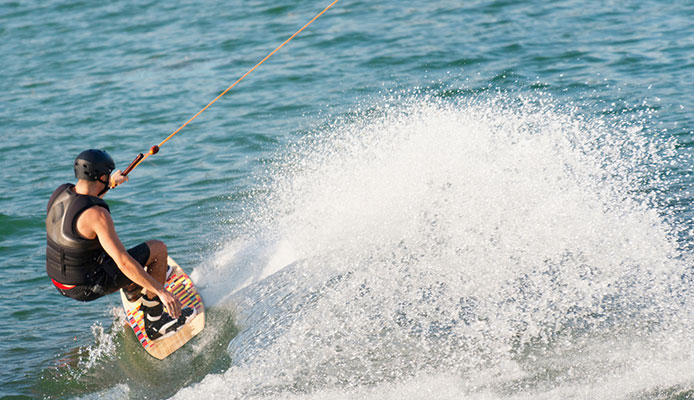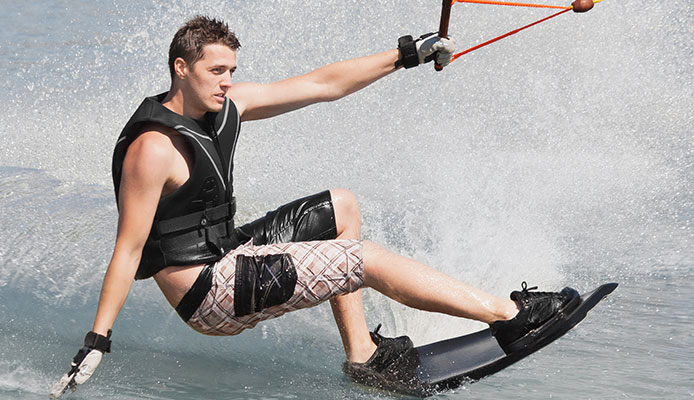
Doing something new is intimidating, and wakeboarding is no exception. The good news, however, is that learning how to wakeboard is very rewarding and incredibly fun, plus, once you understand the basics, you unlock a whole new world of possibilities on the water.
From showing you how to choose the right wakeboarding gear to the steps you need to follow when making turns on the water, this wakeboarding for beginners guide has everything you would need to get started. With progress coming quickly, the following steps should help you glide across the wake in no time.
A Step by Step Guide on How to Wakeboard
1. Get the Right Board
Specially designed, beginner wakeboards seek to offer predictability, comfort, and stability, giving you a perfect platform to learn on. If you are getting started with wakeboarding for beginners, you should lean towards a longer wakeboard – the extra length makes the wakeboard easier to control and more stable.
The best beginner wakeboards feature a smooth continuous rocker because it offers the riders a more predictable feel in the water. Finally, wakeboard for beginners are shaped to offer stability rather than speed and air, and some may feature designs that make them much easier to turn, especially on the rider’s toe side.
2. Get Good Wakeboarding Boots
Also known as bindings, wakeboarding boots hook onto the wakeboard, holding you in place during the ride. When focusing on wakeboarding for beginners, look for stiffer, less flexible boots. It is much easier to steer and balance the board when the ankles are locked into place tightly.
3. Find a Good Driver and Spotter
You should make sure that the towboat driver understands that you are a beginner. Ask the driver to take it slow with you, reserving the speeding up to when you have more experience. Since you will likely fall several times in the beginning, ask your driver to slow down before turning around and coming to retrieve you – this will help you avoid getting caught in choppy waves.
A spotter is someone on the towing boat – other than your driver – that keeps an eye on things while you are focusing on learning how to wakeboard. Look for an experienced spotter – that is, someone who can alert your driver whenever objects or boats appear nearby, or if you happen to fall.
4. Determine Which Foot to Put Forward
If you are goofy or regular footed in other board sports – like surfing and snowboarding – you will most likely be the same way when wakeboarding. If you are not sure, think about which foot you often use to kick a ball and place the foot in the back. You will want your non-dominant foot to face forward.
Note:
- If you are regular footed, the left foot will face forward on the wakeboard.
- If you are goofy footed, the right foot will face forward on your board.
5. Put on a Life Jacket and Get the Right Rope
A wakeboard life jacket will help you remain afloat as you are waiting to get towed. As an additional benefit, it can protect you from serious injury while wakeboarding.
Invest in a short wakeboarding rope during your initial tows. A shorter rope will put you in the narrow part of the wake, making it much easier for you to stand on the board. Invest in a rope with a length of between 30 and 50 feet.
You might also like: How To Jump On A Wakeboard?
6. Get in the Water
With your wakeboard helmet on your head and your wetsuit or rash guard on, sit on the boat’s swim platform and slide your feet into your boots – at this stage, the boots should be attached to the board. Once you are strapped in, place the wakeboard in the water and then slide off the edge slowly until you are off the boat.
Your board should be sitting on its side in the water – that is, the boat’s bottom should be perpendicular to the water surface. Bend your knees so they are touching your chest and stretch both arms out in front of you while you are holding the tow rope handle.
7. Get Up on the Wakeboard
One of the trickiest parts of wakeboarding for beginners, getting up on a wakeboard is the step that precedes gliding on water. Once you are in the water, you will need to make sure that your body is relaxed, and do not try to pull yourself up. Allow the boat to do the work of pulling you up on the board.
Once the boat starts moving forward and the tow rope begins to pull, let yourself be pulled onto the wakeboard. Keep the knees bent and relaxed and do not rush to stand up. If you move too quickly, you will end up losing balance.
Gradually, raise yourself to a standing position. Since the boat is increasing its speed, you will need to position yourself in a steady and balanced stance. Keep your knees bent slightly but not locked. Your arms should be stretched out in front of you, holding the rope’s handle.
Once you are up, bring the rope handle around to your side. Line its handle up with the leading hip and then turn your head to look over the leading shoulder. Do not look at your board as this can cause balance loss, leading to face planting. Instead, focus on looking straight ahead.
8. Steer Your Board
To steer, you won’t need to turn the actual board – turning the board can cause you to fall. Instead, apply pressure to your toes (the board’s front edge) and the heels (the board’s back edge) to curve through the water and make your turn.
9. Wait to be Retrieved if You Fall
If you find yourself raising the rope’s handle or holding it up to the chest, steadily and slowly move it back down. Holding the handle too high up can lead to falling.
It is, however, worth noting that when learning how to wakeboard, falls are common. While the falls can be painful, you must avoid panicking. Once your towboat driver turns around, signal them that you are OK and would like to try again.
If you are not holding the rope, allow your driver to put the boat in neutral before grabbing hold of the rope’s handle. Get back in the starting position and signal the driver that you are ready to start.
10. Use Proper Hand Signals
Before removing your board from the wakeboard rack, you must familiarize yourself with wakeboarding signals. These should make communication easier once you are in the water:
- Thumbs up for speed increase – Wait until you are up on the wakeboard or the driver has slowed down. Hold your thumb up steady if you want just a small speed increase. If you need a bigger speed increase, wave the thumb up and down.
- Thumbs down for speed reduction – Ensure that your hand is far enough away from your upper body that the spotter or boat driver can see it. Do a steady thumbs down for a small speed reduction. For a larger speed decrease, wave the thumbs down signal.
- Pat the top of your head to stop – Patting the top of the head alerts the spotter and driver that you are ready to stop. Once you are confident that your spotter has seen the signal, you can drop the rope handle and wait for the driver to come and retrieve you.
FAQs

Q: Is It Easy to Wakeboard?
Relatively quick to learn, wakeboarding will give you your fix sooner than you expect. Unlike other complicated water sports, wakeboarding features a satisfyingly shallow learning curve and depending on previous board experience and level of confidence, you can be doing ollies and carving up watery storms on the first try. It is, however, worth noting that people without previous board experience may need several lessons to get all the basics.
Q: How Do You Control A Wakeboard?
The correct way to steer your wakeboard is to lean on your toes or heels. Shifting your weight to the front or back of the board allows you to curve water, making the needed turn. Trying to forcefully turn the wakeboard is not recommended, as this can cause you to lose balance.
Q: What Speed Should You Pull A Wakeboarder?
The ideal speed to tow a wakeboard falls between 15 and 25 mph – this is, however, largely dependent on the wakeboarder’s level of experience. The bottom line is that as the speed increases, the more firm and cleaner the wake becomes, making it much more consistent and easier for riders trying to learn new tricks or jump.
Globo Surf Overview
Providing hits of adrenaline, big air, and a fresh spray of water, wakeboarding is one of the most appealing board sports. Much easier to learn, wakeboarding is accessible to almost everyone – kids and adults can learn how to wakeboard. In this wakeboarding for beginners guide, we have covered the steps you will need to follow to get started with the sport.

